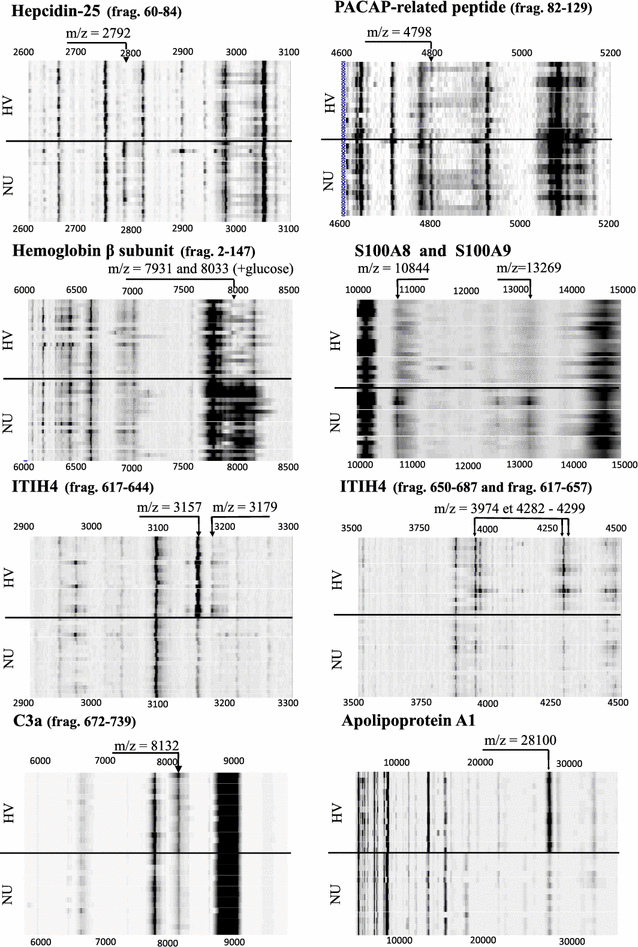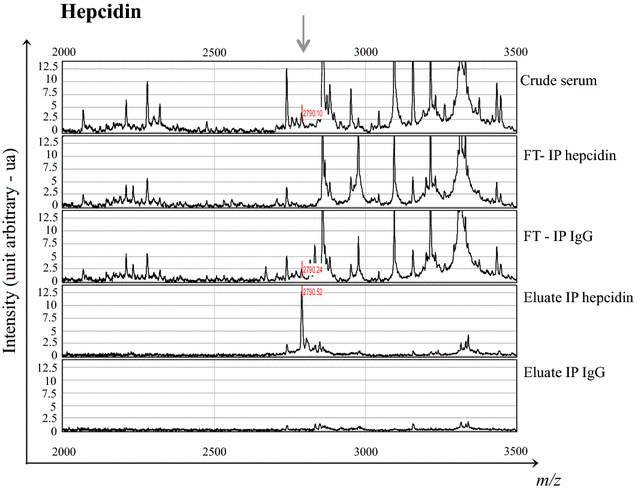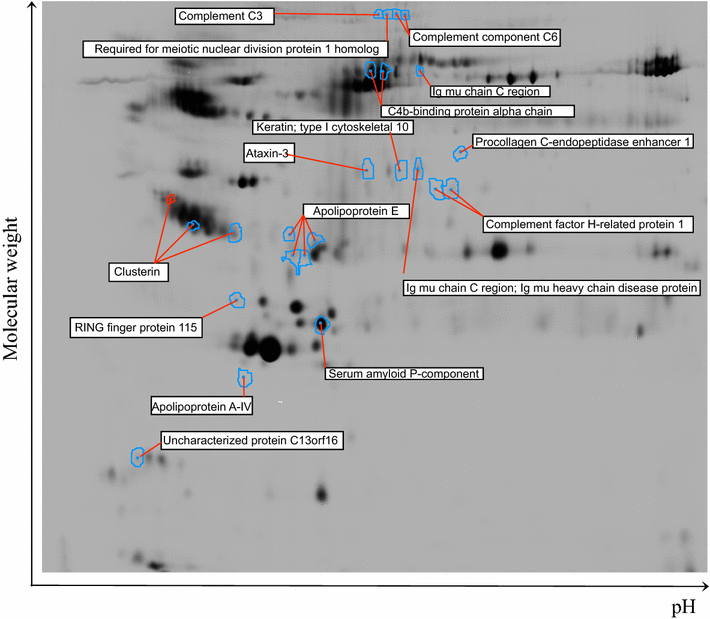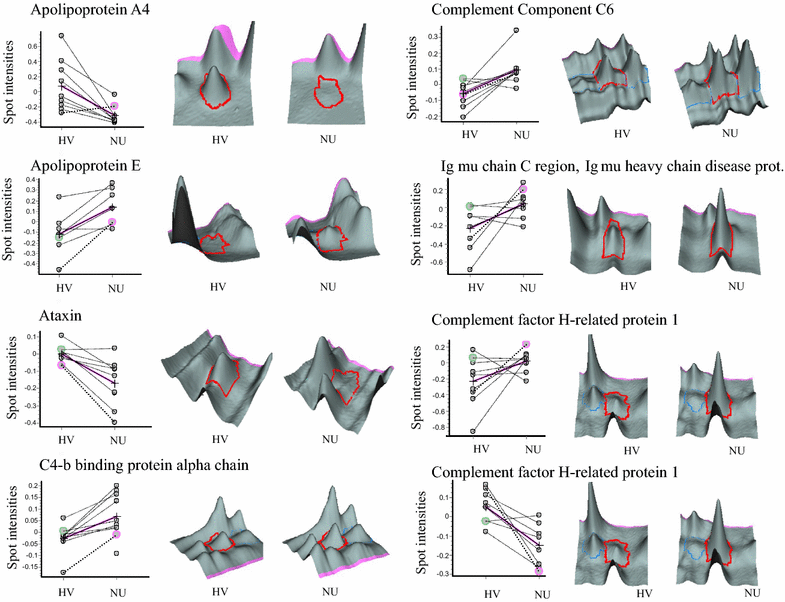Biomarkers of inflammation and innate immunity in atrophic nonunion fracture
- PMID: 27599571
- PMCID: PMC5011805
- DOI: 10.1186/s12967-016-1019-1
Biomarkers of inflammation and innate immunity in atrophic nonunion fracture
Abstract
Background: Nonunion is a failure of healing following a bone fracture. Its physiopathology remains partially unclear and the discovery of new mediators could promote the understanding of bone healing.
Methods: Thirty-three atrophic nonunion (NU) patients that failed to demonstrate any radiographic improvement for 6 consecutive months were recruited for providing serum samples. Thirty-five healthy volunteers (HV) served as the control group. Proteomics studies were performed using SELDI-TOF-MS and 2D-DIGE approaches, associated or not with Proteominer® preprocessing, to highlight biomarkers specific to atrophic nonunion pathology. Peak intensities were analyzed by two statistical approaches, a nonparametric Mann-Whitney U tests (univariate approach) and a machine-learning algorithm called extra-trees (multivariate approach). Validation of highlighted biomarkers was performed by alternative approaches such as microfluidic LC-MS/MS, nephelometry, western blotting or ELISA assays.
Results: From the 35 HV and 33 NU crude serum samples and Proteominer® eluates, 136 spectra were collected by SELDI-TOF-MS using CM10 and IMAC-Cu(2+) ProteinChip arrays, and 665 peaks were integrated for extra-trees multivariate analysis. Accordingly, seven biomarkers and several variants were identified as potential NU biomarkers. Their levels of expression were found to be down- or up-regulated in serum of HV vs NU. These biomarkers are inter-α-trypsin inhibitor H4, hepcidin, S100A8, S100A9, glycated hemoglobin β subunit, PACAP related peptide, complement C3 α-chain. 2D-DIGE experiment allowed to detect 14 biomarkers as being down- or up-regulated in serum of HV vs NU including a cleaved fragment of apolipoprotein A-IV, apolipoprotein E, complement C3 and C6. Several biomarkers such as hepcidin, complement C6, S100A9, apolipoprotein E, complement C3 and C4 were confirmed by an alternative approach as being up-regulated in serum of NU patients compared to HV controls.
Conclusion: Two proteomics approaches were used to identify new biomarkers up- or down-regulated in the nonunion pathology, which are involved in bone turn-over, inflammation, innate immunity, glycation and lipid metabolisms. High expression of hepcidin or S100A8/S100A9 by myeloid cells and the presence of advanced glycation end products and complement factors could be the result of a longstanding inflammatory process. Blocking macrophage activation and/or TLR4 receptor could accelerate healing of fractured bone in at-risk patients.
Keywords: 2D-DIGE; Apolipoprotein; Biomarkers; Complement; Hepcidin; Innate immunity; Nonunion; Proteomics; S100A8; SELDI.
Figures





Similar articles
-
Discovery of new rheumatoid arthritis biomarkers using the surface-enhanced laser desorption/ionization time-of-flight mass spectrometry ProteinChip approach.Arthritis Rheum. 2005 Dec;52(12):3801-12. doi: 10.1002/art.21607. Arthritis Rheum. 2005. PMID: 16320331 Clinical Trial.
-
Discovery of diagnostic biomarkers for pancreatic cancer in immunodepleted serum by SELDI-TOF MS.Pancreatology. 2012 Mar-Apr;12(2):124-9. doi: 10.1016/j.pan.2012.02.009. Epub 2012 Feb 21. Pancreatology. 2012. PMID: 22487522
-
Monomeric calgranulins measured by SELDI-TOF mass spectrometry and calprotectin measured by ELISA as biomarkers in arthritis.Clin Chem. 2008 Jun;54(6):1066-75. doi: 10.1373/clinchem.2007.099549. Epub 2008 Apr 24. Clin Chem. 2008. PMID: 18436720
-
Proteomics: Unraveling the Cross Talk Between Innate Immunity and Disease Pathophysiology, Diagnostics, and Treatment Options.Adv Exp Med Biol. 2024;1443:221-242. doi: 10.1007/978-3-031-50624-6_12. Adv Exp Med Biol. 2024. PMID: 38409424 Review.
-
Molecular pathogenesis of fracture nonunion.J Orthop Translat. 2018 May 31;14:45-56. doi: 10.1016/j.jot.2018.05.002. eCollection 2018 Jul. J Orthop Translat. 2018. PMID: 30035032 Free PMC article. Review.
Cited by
-
Antimicrobial Peptide Combined with BMP2-Modified Mesenchymal Stem Cells Promotes Calvarial Repair in an Osteolytic Model.Mol Ther. 2018 Jan 3;26(1):199-207. doi: 10.1016/j.ymthe.2017.09.011. Epub 2017 Sep 14. Mol Ther. 2018. PMID: 28988712 Free PMC article.
-
Maillard Proteomics: Opening New Pages.Int J Mol Sci. 2017 Dec 12;18(12):2677. doi: 10.3390/ijms18122677. Int J Mol Sci. 2017. PMID: 29231845 Free PMC article. Review.
-
Association between Bone Turnover Markers and Fracture Healing in Long Bone Non-Union: A Systematic Review.J Clin Med. 2024 Apr 17;13(8):2333. doi: 10.3390/jcm13082333. J Clin Med. 2024. PMID: 38673606 Free PMC article. Review.
-
miR-381 modulates human bone mesenchymal stromal cells (BMSCs) osteogenesis via suppressing Wnt signaling pathway during atrophic nonunion development.Cell Death Dis. 2019 Jun 17;10(7):470. doi: 10.1038/s41419-019-1693-z. Cell Death Dis. 2019. Retraction in: Cell Death Dis. 2024 Apr 19;15(4):280. doi: 10.1038/s41419-024-06650-5. PMID: 31209205 Free PMC article. Retracted.
-
Impact of osteoporosis and osteoporosis medications on fracture healing: a narrative review.Osteoporos Int. 2024 Aug;35(8):1337-1358. doi: 10.1007/s00198-024-07059-8. Epub 2024 Apr 8. Osteoporos Int. 2024. PMID: 38587674 Free PMC article. Review.
References
-
- Hernigou P, Beaujean F. Bone marrow in patients with pseudarthrosis. A study of progenitor cells by in vitro cloning. Revue de chirurgie orthopedique et reparatrice de l’appareil moteur. 1997;83:33–40. - PubMed
-
- Mathieu M, Rigutto S, Ingels A, Spruyt D, Stricwant N, Kharroubi I, Albarani V, Jayankura M, Rasschaert J, Bastianelli E, Gangji V. Decreased pool of mesenchymal stem cells is associated with altered chemokines serum levels in atrophic nonunion fractures. Bone. 2013;53:391–398. doi: 10.1016/j.bone.2013.01.005. - DOI - PubMed
-
- Niikura T, Lee SY, Sakai Y, Nishida K, Kuroda R, Kurosaka M. Causative factors of fracture nonunion: the proportions of mechanical, biological, patient-dependent, and patient-independent factors. J Orthop Sci Off J Jpn Orthop Assoc. 2014;19:120–124. - PubMed
Publication types
MeSH terms
Substances
LinkOut - more resources
Full Text Sources
Other Literature Sources
Research Materials
Miscellaneous

